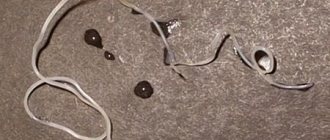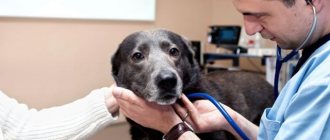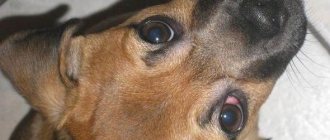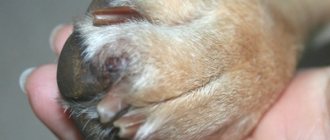Balanoposthitis in dogs is a rather delicate disease and occurs, as a rule, in males. There is a strong opinion among patients and veterinarians that balanoposthitis in dogs occurs only in older individuals. However, this statement is completely false. This scourge can even attack puppies. This article will discuss in detail the causes, symptoms, and treatment of balanoposthitis in dogs.
Causes of balanoposthitis in dogs
This is a multifactorial disease, first affecting the foreskin, and then spreading to the penis. The list of causes of pathology includes:
- Traumatic injuries to the genital organ.
- Phimosis (abnormal fusion of the prepuce, congenital or acquired, when it is impossible to expose the head of the penis).
- Allergic reactions.
- Diabetes.
- Purulent urethritis.
- Bacterial infections.
- Neoplasms (papillomas, warts, etc.).
- STDs (infections that are transmitted during mating).
- Mycoses (fungal pathological flora).
- Foreign bodies.
More often, balanoposthitis is diagnosed in males of large breeds, as well as in dogs whose owners neglect hygiene and do not periodically wash the genitals. At risk are males who randomly engage in mating, are released outside and are not controlled.
Main reasons
Prepuceal discharges can be bloody, purulent or urinary. A normal, healthy dog may produce a small amount of yellowish lubricant, and it may also form around the prepuce. This is considered normal, and treatment in this case is not necessary.
If you are worried, and your animal’s discharge confuses you, it is better to contact a veterinarian for examination. Most often, such discharge is caused by inflammation, but it also occurs due to other diseases. If the cause is a disease of the genitourinary tract, then it may be problems with the bladder, prostate gland, or due to the presence of stones in the urinary tract.
In young dogs, the cause of discharge is often an inflammatory process of the preputial sac. Often associated with maturation of the reproductive system. Veterinarians also identify several factors that cause discharge:
- Trauma or cancer. Occurs more often in adult pets.
- Poor blood clotting, low platelet count. Possible infection from rat poison. This happens less and less, but this cause is considered dangerous, and there is a possibility of a person becoming infected.
Urinary incontinence
Inflammation of the foreskin of the penis. One of the most common causes of discharge in both puppies and adult males. If you are faced with the fact that a male dog has discharge from a pee, in any case, the animal requires proper care and timely treatment.
Types and signs of the disease
Table No. 1 Forms and manifestations of balanoposthitis
| Form | Sign |
| Simple | Small erosions may be noticeable on the mucous membrane. |
| Pustular-ulcerative | The formation of many pustules filled with thick, yellowish contents. When they burst, ulcers form. |
| Erosive | Whitish growths are visible; when they are damaged, areas of erosion are formed. |
| Follicular | If you palpate the area of the prepuce under your fingers, you will find small, dense nodules. |
| Spicy | There is an increase in body temperature, swelling and inflammation of the prepuce, regional lymph nodes are enlarged. |
| Gangrenous | The pathological process spreads to the penis, tissues die, general intoxication of the body, weakness, depression, and high temperature are observed. |
| Chronic | The long course of the disease causes phimosis due to tissue scarring. Enlarged lymph nodes, hyperthermia. The dog feels constant pain due to cracking and inflammation of the glans penis. |
What will the doctor do?
At the clinic, the doctor will conduct an examination and, depending on the expected diagnosis, additional tests may be prescribed.
In most cases, for balanoposthitis, only local treatment is used; for the follicular form of balanoposthitis (when blisters form on the mucous membrane of the penis), cauterization or removal of the follicles is performed; this is a painless procedure and it does not require special preparation of the animal. If any formations are detected in the area of the penis or prepuce, additional cytological studies are carried out. Further treatment depends on the results of the studies.
It is worth mentioning such a disease as venereal sarcoma. With this disease, ulcerated, bleeding formations can form on the mucous membrane of the genital organs. This disease is oncological and, as a rule, responds well to chemotherapy drugs. This disease can be contagious to other dogs and transmitted through contact.
If the discharge comes directly from the urethra, then further diagnostic and therapeutic measures will most likely include ultrasound, possibly x-ray examination, and urinalysis. Treatment will depend on the disease identified.
Although balanoposthitis is not a contagious disease, if you have a stud dog and you notice this problem in him, then 5-7 days before mating you need to treat the preputial sac, as recommended above. If the discharge does not go away, be sure to show your dog to a doctor. These diseases do not pose any danger to people, but it is still worth observing personal hygiene measures. If your pet has discharge from the prepuce, and you have small children in the house, then it is worth treating the floors with any household disinfectant.
Clinical symptoms of balanoposthitis
If there are no problems with the genitals, the male rarely pays attention to them. But even with a slight inflammatory reaction, the dog becomes restless, often licks the penis, takes forced positions, and tries not to press it.
In advanced cases, the dog’s behavior changes dramatically; he refuses games and food, tries to find a secluded place, and constantly licks the penis. If there is pain, a burning sensation when urinating, it squeals.
External symptoms:
- Purulent, yellow-green discharge. When there is a large accumulation, they stick around the head with a dried crust or hang down in a thick strand.
- When tissue damage or erosion occurs, red discharge appears.
- There is swelling and redness around the penis.
Normally, the hair around the penis is dry and the skin is clean. If discharge appears, especially purulent, the coat becomes sticky, and with constant licking, the skin begins to become wet and red. The addition of a secondary bacterial infection results in severe suppuration and the development of dermatitis. There is no appetite, the temperature rises.
Discharge from the loop: normal or disease?
Discharge from a dog's loop can be divided into physiologically normal, which can occur in a healthy animal, and pathological.
A healthy dog's discharge should be clear. They can be different in consistency and resemble mucus. They may also contain a small amount of blood. The discharge should not have an unpleasant odor. They occur during estrus, before childbirth, and also some time (usually several days) after it. If your pet's discharge is exactly like this, there is nothing to fear.
Purulent discharge in a dog is considered pathological. They may be white, yellowish or green and have an unpleasant smell. They may contain some blood. If you find this kind of discharge in your dog, it is most likely caused by some kind of illness.
The following diseases can cause pathological discharge in four-legged animals.
Diagnostics
You should contact a veterinary clinic at the first signs of an inflammatory process on the dog’s genitals. Balanoposthitis is easier to treat at the very beginning, when there are signs of anxiety in the dog and redness of the prepuce. During the examination the following is prescribed:
- Inspection, carefully examine the foreskin, penis, exclude/confirm wounds, foreign bodies, neoplasms, etc.
- Otoscopy.
- Endoscopy.
If a systemic infection is suspected, a biochemical and clinical blood and urine test is performed. They do tests for sexually transmitted infections (mycoplasmosis, chlamydia, etc.), bacterial cultures.
Symptoms of discharge
During exudations from the penis, the dog may have different symptoms, namely:
- Slight swelling of the foreskin.
- Excessive attention of the animal to the penis.
- Severe lethargy, lack of activity.
- Refusal of food.
Sometimes there is a refusal to drink water, which can lead to dehydration. Significant lethargy and excessive discharge indicate a possible problem in the animal. These symptoms may occur to varying degrees. To establish a diagnosis and prescribe treatment, the doctor must conduct the following tests:
- Blood test (biochemical), as well as urine test.
- Cytology of discharge.
- Urine culture to detect possible infections.
- Blood clotting test.
- Ultrasound for a complete picture of the condition of the bladder and prostate gland.
When is the best time to ask for help?
Every dog owner should remember to make timely and regular visits to the veterinarian. Especially if there are reasons for concern. If you see symptoms such as: abundant discharge, often purulent and bloody, possible redness or swelling of the foreskin, then you should immediately seek help.
The doctor must carefully examine the animal and conduct all necessary tests. Even a slight deterioration in condition can lead to serious consequences.
Purulent discharge
If you see pus from a dog's pee, or that the dog's pee is festering, you should immediately seek veterinary help. Such purulent discharge may indicate inflammation of the penis, in other words, balanoposthitis.
During such a disease, the animal may have purulent or bloody discharge from the genital organ, which smells very unpleasant, and the dog may lick the weeny often and for a long time. Often at this time the dog may be slightly irritated and twitchy; during walks it may also be distracted by emissions and begin to lick itself.
The causes of balanoposthitis are: bacterial or herpesvirus infections, the presence of a foreign body, severe injury, insufficient amount of lubricating fluid in the animal. After diagnostics, which includes preputation and tests for microorganisms, the dog may be prescribed treatment. Before this, an antibiotic sensitivity test should also be performed.
What is used in the treatment of balanoposthitis?
The basis of treatment is eliminating the cause of the disease. Acting only on symptoms will not give positive dynamics and balanoposthitis will constantly return.
The course of therapy includes:
- Hygienic treatment of the external genitalia of a male dog. The wool is cut. The prepuce and head of the penis are treated with antiseptic solutions (Miramistin, Chlorhexidine, 0.05% Dioxidine).
- The preputial cavity is washed with antiseptics (Chlorhexidine).
- Prescription of antifungals, antibiotics (Clamoxil LA), antivirals, immunomodulators (Imunofan), antiallergic drugs. Complex products: Cantharis compositum, Traumeel and Echinacea compositum. It all depends on what exactly formed the basis for the development of balanoposthitis or a secondary infection.
Minor damage to the skin and tissue of the penis can be eliminated at home. Up to 3 times a day, the problem area is washed with a syringe (Furacilin solution); for severe inflammation, Chlorhexidine or Miramistin are used.
After washing, the head of the penis is exposed and a thin layer of ointment with disinfectant and antibacterial properties is applied (Levomekol, synthomycin or neomycin emulsion, Tetradelta, cycloferon liniment).
After the procedure, the dog must be wearing a protective (Elizabethan) collar to prevent licking of the ointment and permanent injury to the foreskin with the tongue.
In case of a chronic process, pain, the dog will not allow manipulation, so you have to use sedation (anesthesia).
For phimosis, treatment is only surgical; the head of the penis must be freed from the deformed foreskin to be able to carry out hygienic procedures.
In advanced cases, with gangrene, removal of dead tissue will be required. Rarely, resection of the penis is performed followed by reconstruction of the urethra.
Important! Males that do not have breeding value and will not be allowed for breeding are recommended to be castrated. This way you can reduce the likelihood of infection during self-walking and random mating. The dog owner must inspect the genitals every 2-3 days, wash the preputial sac and the head of the penis.
Kidney inflammation
. This disease is very rare in dogs. It is caused by mechanical damage to the kidney area, bruises, blows, etc., in very rare cases - a cold or some ingested caustic substance.
Symptoms. First there is a fever, then a tense gait and a tightened butt; when you touch the lumbar region, the animal detects pain, urine either does not come out at all, or in very small quantities - first dark brown, then bloody in color, and finally mixed with pus. Stools are rare and dry. In dangerous cases of this disease, the dog lies or sits and appears paralyzed.
Treatment. Initially, Aconite 3 is given in 3-4 doses, after 1/2 hour, 5 grains or drops. Further, if the cause of the disease is mechanical damage, use Arnica 3 and Aconite 3, alternately. If the urine is dark, bloody and comes out in drops and the fever has subsided with the help of Aconite, then Cantharis 3 is indicated, hourly, and then Hyoscyamus 3.
It would be good to cover the dog with a warm blanket, give it only soft, digestible food - milk porridge, oatmeal, etc., and clean, fresh, but not cold water to drink. Skin care is essential. Light brushing for short-haired dogs is very beneficial. During the warm season, you can bathe a sick dog in summer (25′) water daily. After the bath, thorough rubbing is necessary.
Cystitis
. This disease is very rare in dogs, occurring only in males. Causes. The same as for kidney inflammation.
Symptoms. The dog's gait is tense, its backside seems to be broken. Frequent urge to urinate, but urine either does not come out at all, or only in drops. When examining with a finger through the rectum, the filled bladder is felt in the form of a ball, it is hot and very painful with the slightest pressure. If there are urinary stones in the bladder, the urine is blood-colored. The sick animal is extremely restless, breathing is difficult, the temperature is elevated; muzzle is hot and dry; bowel movements are rare and very painful.
Treatment. Several doses of Aconite 3, after 1/41/2 hours, 5 grains or drops - until the fever stops; then Cantharis 3, after 2 hours. If the illness occurs because the dog has eaten something spicy or irritating (for example, turpentine, Spanish flies, etc.), then give a few drops of Camphor rubini, after 1/4 - 1/2 hour.
They are fed mucous decoctions, highly diluted with water. The presence of stones in the bladder requires surgical treatment.
Bladder neck spasm
. Blocks the urinary passage from the bladder. Causes. Prolonged urinary retention, colds and ingestion of caustic substances (for example, Spanish flies).
Symptoms. Frequent urge to urinate, in which even the discharge of a few drops is accompanied by very severe pain. At the beginning of the disease there is no fever, but soon it appears, and the animal becomes restless and feels pain when pressure is applied to the perineum.
Treatment. Aconite 3, after 1/2 hour, 5 grains or drops, in 3-4 doses, and then alternately with Hyoscyamus 3, after 1-2 hours. If there is no rapid improvement, then give Cantharis 3 after 2 hours.
Bloody urine
. It occurs in dogs as an independent disease after injuries from blows, bruises, being run over by a car, etc., as well as after excessive stress during copulation.
Treatment. Aconite 3 and Arnica 3, alternately after 1-2 hours, 5 grains or drops and hot dry poultices on the kidney (lumbar) area. Otherwise, adhere to the indications mentioned in the case of bloody urine in other diseases.
Condylomas (warts) on the bridle
. Often in male dogs, on the skin of the oud, where the cartilage ends, spongy, dark red growths of various sizes appear, bleeding easily, which are called warts and condylomas. They appear in most cases as a result of infection or damage during copulation. The presence of condylomas is indicated by bloody discharge from the foreskin during and after urination. When examining a dog, they are easy to detect on the head and in the indicated places on the foreskin.
Treatment. Frequently wash the foreskin, lubricate the swelling with a brush with Thuja tincture 4 - 5 times a day. Orally 4 - 5 times a day Thuja 3, 5 grains or drops.
Diabetes (diabetes).
Very rare in dogs. It manifests itself as abundant discharge of light-colored urine of low specific gravity (due to the low content of solid components in it).
Causes. Spoiled, sour, moldy or very salty food or drink; hard - therefore, water rich in lime or other salts; caustic diuretics accidentally ingested into food; a cold or excessive stress during intercourse.
Symptoms. At first, nothing is noticed other than very copious urination. Later, the dog weakens, the coat loses its shine, becomes disheveled, the mucous membranes become pale or dirty yellow, the appetite decreases - and the animal loses weight. Subsequently, the butt is taken away and the dog dies from exhaustion. This disease affects both young and old dogs. If a dog is weak and malnourished, it is difficult to save it. Healthy and strong dogs are cured in most cases.
Treatment. Pulsatilla 3, after 2 hours, 5 grains or 3 drops. Acidum pitrik 3 - if the 3rd disease was a consequence of salty food. Arsenic 3 is indicated when other remedies have failed. The dog's food should be unsalted, healthy, consisting of raw meat with blood and soft water. In addition, peace and a moderately warm room are necessary.
Involuntary urination
. Often, dogs of both sexes secrete urine in drops or streams - involuntarily and completely unnoticed by them. This deficiency, occurring in old dogs, indicates paralysis of the obturator muscle of the bladder, which is usually incurable. Sometimes this phenomenon serves as a concomitant sign of other diseases.
Treatment. When Causticum is taken orally 3-4 times a day, 5 grains or drops, urinary incontinence is sometimes cured. If it is caused by excessive sexual irritation, then it is useful to give Phosphorus 3. In puppyed bitches, this disease goes away on its own after whelping.
Inflammation of the testicles and scrotum
. It is often found in dogs and is easily recognized by its gait - wide and tense, especially in the hind legs. Moreover, the dog often stops while running at full speed and licks the sore spots. Upon examination, the scrotum is found to be swollen, hot, red and painful. With an inflamed testicle, these symptoms are more pronounced.
Causes. In most cases, mechanical damage and excessive sexual arousal.
Treatment. Aconite 3 and Arnica 3, after two hours, 5 grains or drops. If the inflammation has reached a high degree, then Mercurius solubilis 3, a spoonful, with threatening hardening - Konium 3, 5 grains or drops after 2 hours. Sometimes Geparsulfuris 3, a spoonful 4 times a day, also helps very well.
Phimosis
(nezalupa)
and paraphimosis
(strangulation of the foreskin). The first name refers to a narrowing of the opening of the foreskin - so much so that the penis cannot lengthen and copulation is impossible. Urine comes out only in drops. The edges of the flesh are thickened and very inflamed.
Paraphimosis, or the so-called Spanish collar, is characterized by the fact that the strongly swollen dark red head of the oud is pinched in a ring of narrowed foreskin, which is also swollen. At the site of the injury, abscesses form, which are very painful, and urine is retained.
Causes. Damage and infringement of the edges of the foreskin. Paraphimosis often occurs during violent copulation, when the narrowed foreskin moves far away and at the same time, due to stagnation of blood, the head swells.
Treatment. For phimosis - cold Arnica lotions (3 tablespoons per 0.5 liters of water), Arnica 3 orally, after 2 hours. In case of congenital phimosis, an operation consisting of cutting the narrowed foreskin is necessary.
The same treatment applies to paraphimosis; if it fails, grab the foreskin between the index and middle fingers of both hands and straighten the head. After this, the arnica water lotion is continued.
Fracture (tripper).
In dogs, it usually consists of inflammation of the inner side of the foreskin, pain in the catarrh of the mucous membrane of the urethra. It usually happens as a result of the introduction of foreign bodies (hair, sand, etc.) between the head and foreskin or irritation during copulation. This disease, although not contagious, is sometimes transmitted to the bitch.
Symptoms. Sticky yellowish mucus flows from under the foreskin, contaminating the edges of the flesh and sticking together long hair. In this case, the dog does not feel any pain, urination is quite free. Sometimes mucus accumulates between the head of the penis and the foreskin - then the disease is called inflammation of the foreskin and head of the penis (Eicheltripper).
Treatment. For mucous discharge Cannabis x 1 3 times a day, 5 drops; for purulent - Mercurcus solubilis 3 and Hepar sulf. x 3rd plant, alternately after 2 hours on a spoon. In addition, the dog must be restrained from copulation, not let out into the street alone, but taken out on a leash.
Neoplasms (tumors) on the vagina and uterus
. No animal is as susceptible to this disease as the female dog. Most often, the cause is previous damage to the mucous membranes of the vagina and uterus during difficult whelping (but only under the condition of a special location).
Symptoms. The presence of these formations in the vagina is recognized by the discharge of mucus, blood or smelly pus. However, for an accurate diagnosis it is necessary to conduct a finger examination by directly feeling the warty growths. Sometimes there is no such need, since the tumors fall out of the pudendal fissure. If the tumors are in the uterus, then the diagnosis is more difficult to make - only by the nature of the discharge, which is most often putrid-purulent in nature. New growths in the vagina are easily treated, while uterine swelling in old dogs is incurable.
Treatment. If the dog has a fever, then first give Aconite 3 in several doses, and then Arnica 3 and Thuja 3, 5 grains or drops once a day. In addition, they wash the external parts and douche the vagina (30 drops of Arnica tincture per glass of water).
For spongy, easily bleeding neoplasms, you should give Thuja 3 and Witch Hazel 3, 5 grains or drops each, and douche 2 times a day (20 drops of Thuja tincture per glass of water).
Keep the dog clean and provide light, nutritious food.
Inflammation of the udder (mammary glands).
This disease is rarely observed. Occurs as a result of a bruise or after puppies are weaned from the udder too early.
Symptoms. The mammary glands swell, the skin turns red and becomes tense and painful. Milk secretion stops and fever appears.
Treatment. If the cause of the disease is a bruise, then give Arnica 3, after 1 hour, 5 grains or drops, and make a lotion of 1 teaspoon of Arnica tincture in 2 glasses of water.
In case of fever, Aconite 3 and Arnica 3 are indicated alternately after 1-2 hours. If the tumor is hard and red, then give Belladonna 3 in the same manner; if the tumor turns into suppuration, then Mercurius solubilis 3 and Hepar sulfuris 3, alternately after 1 hour, a spoonful. When palpating nodes in the tumor, Conium 3 and Calcarea carbonica 6 are prescribed, 5 grains or drops every 3 hours, alternately.
Prolapse of the uterus and vagina
. It happens in bitches - often with general weakness as a result of tension during copulation, forced separation during this act, and finally, from rough assistance during whelping.
Symptoms. When the uterus prolapses, a frequent, unsuccessful urge to urinate is first noticed, then a round, soft tumor appears from the vagina. The animal becomes restless, does not eat anything, and begins to feel feverish. In this case, it is necessary to set and hold the prolapsed uterus in place. To do this, wash it with lukewarm water, lubricate it with boric petroleum jelly and carefully push it into place with a clean hand. Then douching is done (a solution of 1 teaspoon of Arnica tincture in a glass of lukewarm water), Arnica 3 and Nux vomica 1 are given orally, after 1/2 hour, 5 grains or drops, in several doses, and then after 2-3. If the loss occurred after whelping, without any damage, then give Pulsatilla 3, after 1-2 hours, 1 dose. In any case, it is useful to start treatment with several doses of Aconite 3.
Incorrect whelping
. The birth of a puppy usually occurs in dogs without any outside help. Sometimes deviations occur—difficulties arise that require artificial assistance.
The absence of attempts during normal childbirth occurs in small, pampered lap dogs due to their general weakness. As an exception, the absence of attempts may be associated with necrosis of the embryonic membranes and their decay in the uterus. In the first case, the dog helps push only at the beginning, and then stops straining. In such a situation, it is necessary to give Hamolilla 3 or Cannabis 3 in several doses every 1/2 hour, alternately, 5 grains or drops each. If this does not help, then Pulsatilla 3. When pushing and general weakness stop, Sekale should be given Cornutum 0. When the birth process stops, Opium 3 is indicated.
In case of rotting of the fetus, it is necessary to induce attempts with several doses of Pulsatilla or Secale Cornutum and as soon as the puppies move towards the vagina, immediately remove them using forceps or by hand.
After a difficult birth, the bitch should be given Arnica 3 in several doses every 1 hour. Often, as a result of whelping from the vagina, the dog experiences anxiety and extreme weakness from blood loss. To quickly contract the uterus and blood vessels, give Sekale Cornutum 0 and Witch Hazel 3 in several doses; in extreme cases, inject Witch Hazel solution into the uterus (1 teaspoon per glass of cold water).
Fetal abnormalities require veterinary attention.
Umbilical hernia
. This is the only hernia found in dogs, and even then it is quite rare. At the site of the navel, in the middle of the lower abdomen, a round, elastic, painless swelling forms, which disappears when pressed and then appears again. Such hernias are cured by applying a solution of 1 part sulfuric acid to 4 parts water, 4 times daily until the swelling disappears. Large hernias require surgical treatment.
Source: New in therapy for cats and dogs. Veterinary homeopathic clinic.
Prognosis and prevention
It is important to notice phimosis early, which prevents normal cleansing of the penis. After walks, especially in mud, the male genitals are washed, the groin and belly are washed.
Every year, at least 2 times, it is recommended to show the dog to a veterinarian in order to promptly identify problems in the genitourinary system. It is better to castrate a dog that is not going to be bred, this will eliminate the possibility of contracting sexually transmitted infections. The prognosis for timely treatment is favorable. In advanced cases, the inflammatory process can spread through the urethra, causing prostatitis, urethritis, pyelonephritis, etc.
Dog blood test
The study can only be carried out using blood from a vein. Prepuce in this case will not show results. Veterinarians warn that there is no vaccine for chlamydia, and the problem can only be combated by excluding infected animals and not by breeding.
Bloody discharge in male dogs may indicate the presence of testicular inflammation. As a result, after diagnosis, the animal is prescribed potent antibiotics, namely the penicillin group or gentamicin.
In order for the treatment to bring a positive result, the animal must be kept in good conditions, avoid hypothermia, reduce the load and reduce the duration of walks, especially in winter, cold times. Inflammation of the testicles or orchitis is usually treated fairly quickly and without complications.
Long-term treatment is possible if orchitis has caused a tumor and severe bleeding. Prostate disease often does not manifest itself clinically, and an accurate diagnosis can only be established at the final stage.
Prostate hypertrophy is common in middle-aged dogs. It affects the urinary system and can cause a perineal hernia. In addition to purulent and bloody discharge, swelling of the paws, poor condition of the dog, weakness and refusal to eat may be present.
This disease can be treated surgically and further therapy with strong antibiotics. Veterinarians warn that during prostate hypertrophy, constipation may occur, which should not be treated with laxatives. It is better to use light herbal infusions and candles. The presence of discharge from the genital organ in a male dog is a common occurrence and usually does not pose a threat to the health of the animal. Especially during puberty, when the discharge is light in color.
In cases where the discharge becomes dark in color and is accompanied by pus and blood, you should consult a doctor. This usually indicates a serious illness and does not go away on its own. Treatment of pus from a dog's pee or blood discharge excludes self-medication. It can cause complications and irreversible consequences. In order not to harm the animal, it is worth visiting a doctor in a timely manner. Even in the presence of serious diseases, with proper treatment, it is possible to eliminate discharge and improve the condition of the animal.
Currently reading:
- Thyroid dysfunction in dogs (hypothyroidism)
- Discharge that is normal in pregnant dogs
- 13 Causes of Indigestion and Diarrhea in Dogs
- We fight warts on the face and body of dogs
Pyometra
This is purulent inflammation of the uterus. This is a very serious disease that can lead to the death of your pet. Pyometra can be open or closed. When the vagina is open, pus oozes out, and by this sign you can easily understand that your pet is sick. When closed, pus accumulates in the uterus, and it is almost impossible to identify pathology. At the same time, due to the fact that pus remains in the body, general intoxication occurs, which can be quite severe. You should not treat pyometra yourself; you should take the animal to a doctor. Most often, the only treatment is to sterilize the bitch.
Sometimes discharge from the loop is observed in sterilized bitches. Their cause is most often cystitis. It can be caused by hypothermia or infection. In case of cystitis, first of all, you should avoid keeping your pet in the cold for a long time. Antibiotics must be administered. In particularly severe cases, bladder lavage may be done.
Pathologies
The stage of the pathology can be judged by the intensity and nature of the clinical signs.
The onset of the disease manifests itself in the form of a scanty liquid secretion, which accumulates in the dog’s organ only in a supine position. The progression of the infection implies a change in the color and consistency of the secretion to white and thick in appearance. Then the pus itself accumulates.
In a supine position, a meager liquid secretion begins to accumulate.
According to the intensity, the pathology differs in its forms: simple, erosive, purulent-ulcerative, acute, gangrenous, chronic form.
Simple form
The simple form is expressed in the scarcity of manifestations and the rather calm behavior of the dog.
The simple form is characterized by the dog's calm behavior.
Erosive form
During the erosive form, the resulting pustules spontaneously open and turn into ulcers.
With the erosive form, the pustules begin to open.
Purulent-ulcerative form
The ulcers then become infected with a pyogenic infection.
The purulent-ulcerative form is characterized by further infection.
Acute form
The acute form is manifested by hyperthermia of the body, increased inflammation in the foreskin, and enlarged lymph nodes.
In the acute form of the disease, the dog's body temperature increases.
Gangrenous form
When the gangrenous form sets in, the animal becomes significantly weaker and the body temperature is constantly high.
The gangrenous form is expressed in constant weakness.
Chronic form
Chronic course implies constant pain at the site of inflammation, the appearance of cracks, scars on the foreskin. Chronic hyperthermia of the body, enlarged lymph nodes.
In the chronic form of the disease, the dog experiences constant pain.
Anti-inflammatory ointments for the management of balanoposthitis
Used if the problem is caused by an allergic reaction or certain skin diseases.
Sinaflan has an anti-inflammatory effect.
It contains a topical glucocorticoid hormone - fluocinol acetonide.
Reduces the inflammatory reaction in the affected area.
The remedy is used for balanoposthitis, when the cause is an allergic reaction.
The course of therapy is a week.
Has many side effects.
Therefore, it is recommended to use it as directed and under the supervision of a physician.
The drug can suppress local immunity and cause infection.
Dermatitis or atrophy of the skin occurs on the skin at the site of use.
If you apply the ointment too much and too often, systemic complications may develop.
Among them are hypercortisolism, gastrointestinal ulcers, and steroid-induced diabetes mellitus.
Advantan also has an anti-inflammatory effect.
The active component is the glucocorticoid hormone methylprednisolone in the form of aceponate.
An effective drug relieves itching, swelling, and redness.
It has a blocking effect on the release of inflammatory mediators.
Used when allergic reactions occur on the penis.
Side effects are minimal.
Blisters and dry skin appear at the site of the lesion.
No systemic reactions were noted.
Elokom contains the glucocorticoid hormone Mometasone.
Has a strong anti-inflammatory effect.
Able to block the release of inflammatory mediators.
For balanitis it is prescribed if the disease is caused by an allergic reaction.
The course of use is one week, side effects are rare.
Usually this is atrophy, dermatitis, dry skin at the site of application of the ointment.
Elocom-S contains salicylic acid in addition to the hormone.
Belosalik based on Betamethasone is considered an analogue of the product.
Antibiotics
When infectious processes become chronic, in addition to daily washing with antiseptic solutions, it is necessary to include antibacterial therapy in the treatment regimen. It often begins with taking a broad-spectrum antibiotic. After receiving the culture result, such an antibiotic can be replaced with another one that acts on certain microorganisms that have caused the development of inflammation.
An important role is played by antiseptic liniments, which are pumped into the prepuce cavity using a syringe. If for any reason the disease cannot be overcome, most often it is necessary to resort to castration.
Treatment by an experienced veterinarian
After contacting a specialist, first of all, a study will be conducted to find the cause of the disease. It is very important to find and remove all adhesions, tumors and scars that could lead to the development of phimosis and balanoposthitis in the dog. As in the case of the mild form, the dog will undergo daily rinsing of the preputial sac, but high-concentration solutions will be used, which are more effective. If the condition begins to worsen, treatment of balanoposthitis in the dog with antibiotics should be started.
Discharge from the anus
Pus may also be discharged from the dog's anus. As a rule, this is a brown discharge with an unpleasant odor. However, the discharge may be of a different color. This is often caused by inflammation of the anal glands, which is called paraproctitis. These glands accumulate odorous secretions and must be emptied regularly. This happens during defecation: feces, when passing through the rectum, put pressure on the glands and thereby empty them. However, if a four-legged animal has frequent diarrhea or, on the contrary, constipation, the secretion does not leave the glands in time, and it stagnates. This leads to inflammation. The anus area swells, turns red, and pus is released from it. To treat paraproctitis, the hair around the anus is cut off and the anus is washed with antiseptics. Then the stagnant secretion and pus are carefully squeezed out of the glands. After these procedures, drug treatment is carried out. Use cyclosporine or ketoconazole. Rectal suppositories are also used, which are administered to the dog daily.
Endormit
This is an inflammation of the lining of the uterus. It occurs due to a hormonal imbalance in the animal. This disease is chronic, but can become acute. The insidiousness of endormitis is that it is very difficult to recognize. Its only symptom may be the inability of the bitch to become pregnant or bear puppies. Discharge may appear, but may be completely absent. Endormitis is most often treated with medication. However, if a successfully treated bitch does not become pregnant, a relapse often occurs after the next heat. In case of severe disease, the animal is sterilized.
Vaginitis
This is a pathology in which the vaginal mucosa becomes inflamed. Discharge with this disease is not numerous, the bitch licks her genitals more often, so vaginitis is often not noticed at all or is mistaken for a normal estrus. If vaginitis is not detected in time and treated, it will cause serious negative consequences for the dog's health. Vaginitis is treated by douching the vagina with miramistin, a weak solution of potassium permanganate or furatsilin. You can apply an antibacterial ointment, such as streptocide, to the inner surface of the vagina. This should be done with a sterile spatula. If these methods do not help, antibiotic treatment is used. Under no circumstances should you try to treat your dog with antibiotics yourself; they should be prescribed by a veterinarian.











